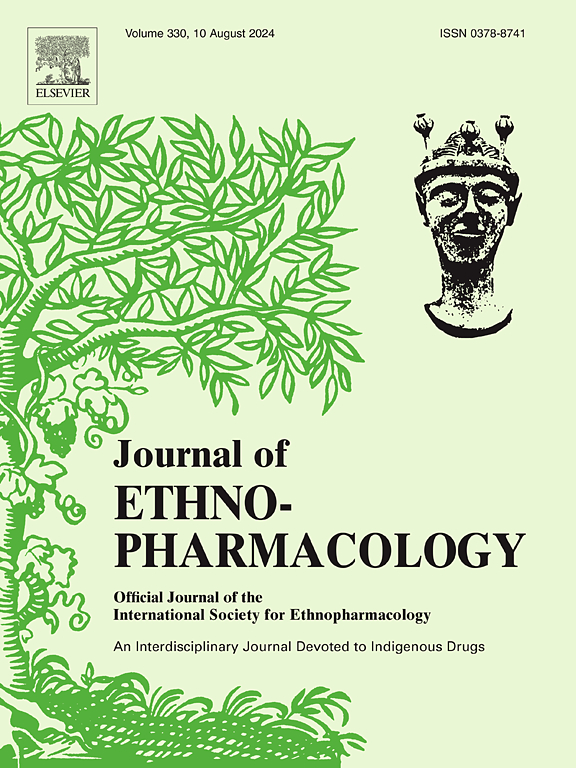Achillea fragrantissima (Forssk.) Sch. Bip. essential oil inhibits the growth of pancreatic cancer cells via induction of necrosis, sub-G1 arrest, modulation of β-catenin/ERK signalling pathways and p38α MAPK, CDK2, EGFR inhibition
IF 4.8
2区 医学
Q1 CHEMISTRY, MEDICINAL
引用次数: 0
Abstract
Ethnopharmacological relevance
Achillea fragrantissima (Forssk.) Sch. Bip. is a medicinal plant that has been traditionally used in several Arab countries such as Egypt, Jordan and Saudi Arabia, for cancer treatment. Studies on the plant's extracts and essential oil showed that they exhibited cytotoxic activity against some cancer cells, however, the oil's activity was poorly studied; often involving MTT/SRB cell viability assays only without further mechanism of action studies.
Aim of the study
To study the anticancer potential of Achillea fragrantissima essential oil (AFEO), investigate its mechanism of action in detail for the first time and identify its chemical constituents.
Materials and methods
Achillea fragrantissima was obtained from Hail, Saudi Arabia, while its essential oil was collected using a Clevenger apparatus. SRB assay was used to assess AFEO's cytotoxic activity against A549 (lung), HCT116 (colon) and PANC-1 (pancreatic) cancer cells, while cell-cycle and apoptosis assays were performed via flow cytometry. Protein expression was analysed via Western blotting, while GCMS was used to analyse AFEO's chemical composition. p38α MAPK, CDK2 and EGFR enzymatic assays were performed via the corresponding assay kits, and molecular docking was conducted using Maestro software.
Results
AFEO demonstrated its most potent activity against PANC-1 cells followed by HCT116 cells with IC50 values of 63 μg/ml and 81 μg/ml, respectively, however, no significant activity was observed against A549 cells. The oil also showed lower toxicity towards healthy HSF cells and demonstrated higher selectivity for the cancer cells. Further studies against PANC-1 revealed that AFEO induced necrosis and sub-G1 phase arrest in the cells. Western blotting revealed that AFEO did not alter caspase-3 expression level, further confirming the lack of apoptosis induction in PANC-1 cells by the oil. Moreover, AFEO downregulated β-catenin expression and this is specifically desirable in the case of pancreatic cancer, however, it upregulated phosphorylated ERK (p-ERK) expression indicating ERK pathway activation. AFEO did not change phosphorylated Akt (p-Akt) and PTEN expression, indicating lack of effect on the Akt pathway. Furthermore, AFEO was found to potently inhibit enzymes related to the ERK pathway and cancer progression in general, with IC50 values of 0.45 μg/ml, 0.23 μg/ml and 0.14 μg/ml against p38α MAPK, CDK2 and EGFR enzymes, respectively. GCMS analysis identified the major bioactive compounds as 3-thujanone (30.51 %), artemisia ketone (4.68 %), eucalyptol (2.57 %) and germacrene D (2.56 %). Finally, molecular docking studies predicted that 3-thujanone would primarily bind to and inhibit p38α MAPK and EGFR, while germacrene D would primarily inhibit CDK2 with binding energies of −7.228 kcal/mol, −5.929 kcal/mol and −5.230 kcal/mol, respectively.
Conclusion
AFEO exhibited anti-pancreatic cancer activity via inhibition of β-catenin pathway and activation of ERK signalling pathway, in addition to p38α MAPK, CDK2 and EGFR inhibition. This is the first study that investigated AFEO's anticancer potential in detail, and it highlights the importance of relying on traditional uses of plants as a guide for discovering novel anticancer agents. This work might serve as a crucial step for further isolation studies to develop AFEO, or its constituents, into effective anticancer agents.

香阿喀琉斯(福斯克)毕普原理图。精油通过诱导坏死、亚g1阻滞、调节β-catenin/ERK信号通路和p38α MAPK、CDK2、EGFR抑制来抑制胰腺癌细胞的生长
民族药理学相关性:香阿喀琉斯(fossk .)毕普原理图。它是一种药用植物,传统上在埃及、约旦和沙特阿拉伯等几个阿拉伯国家用于治疗癌症。对该植物提取物和精油的研究表明,它们对某些癌细胞具有细胞毒活性,然而,对其活性的研究很少;通常只涉及MTT/SRB细胞活力测定,而没有进一步的作用机制研究。目的研究阿基利香挥发油(Achillea fragrantissima挥发油,AFEO)的抗癌潜力,首次详细探讨其作用机制,并鉴定其化学成分。材料和方法从沙特阿拉伯的Hail地区获得了achillea fragrantissima,用Clevenger仪器采集了其精油。采用SRB法检测AFEO对A549(肺)、HCT116(结肠)和PANC-1(胰腺)癌细胞的细胞毒活性,并通过流式细胞术检测细胞周期和凋亡。Western blotting分析蛋白表达,GCMS分析AFEO的化学成分。p38α MAPK、CDK2和EGFR酶促检测通过相应的检测试剂盒进行,分子对接使用Maestro软件进行。结果safeo对PANC-1细胞的抑制作用最强,其次是HCT116细胞,IC50值分别为63 μg/ml和81 μg/ml,而对A549细胞的抑制作用不显著。该油对健康HSF细胞的毒性较低,对癌细胞的选择性较高。对PANC-1的进一步研究表明,AFEO诱导细胞坏死和亚g1期阻滞。Western blotting结果显示,AFEO未改变caspase-3的表达水平,进一步证实了AFEO在PANC-1细胞中不存在诱导凋亡的作用。此外,AFEO下调了β-catenin的表达,这在胰腺癌中是特别可取的,然而,它上调了磷酸化ERK (p-ERK)的表达,表明ERK途径被激活。AFEO未改变磷酸化Akt (p-Akt)和PTEN的表达,表明对Akt通路缺乏影响。此外,研究发现AFEO对ERK通路和肿瘤进展相关的酶有明显的抑制作用,对p38α MAPK、CDK2和EGFR酶的IC50值分别为0.45、0.23和0.14 μg/ml。GCMS分析鉴定其主要活性成分为3-土janone(30.51%)、artemisia酮(4.68%)、eucalyptus tol(2.57%)和germacrene D(2.56%)。最后,分子对接研究预测,3-thujanone主要结合并抑制p38α MAPK和EGFR,而germacrene D主要抑制CDK2,结合能分别为−7.228 kcal/mol,−5.929 kcal/mol和−5.230 kcal/mol。结论afeo除抑制p38α MAPK、CDK2和EGFR外,还通过抑制β-catenin通路和激活ERK信号通路表现出抗胰腺癌活性。这是第一个详细研究AFEO抗癌潜力的研究,它强调了依靠植物的传统用途作为发现新型抗癌药物的指南的重要性。这项工作可能为进一步分离AFEO或其成分开发成有效的抗癌药物提供关键的一步。
本文章由计算机程序翻译,如有差异,请以英文原文为准。
求助全文
约1分钟内获得全文
求助全文
来源期刊

Journal of ethnopharmacology
医学-全科医学与补充医学
CiteScore
10.30
自引率
5.60%
发文量
967
审稿时长
77 days
期刊介绍:
The Journal of Ethnopharmacology is dedicated to the exchange of information and understandings about people''s use of plants, fungi, animals, microorganisms and minerals and their biological and pharmacological effects based on the principles established through international conventions. Early people confronted with illness and disease, discovered a wealth of useful therapeutic agents in the plant and animal kingdoms. The empirical knowledge of these medicinal substances and their toxic potential was passed on by oral tradition and sometimes recorded in herbals and other texts on materia medica. Many valuable drugs of today (e.g., atropine, ephedrine, tubocurarine, digoxin, reserpine) came into use through the study of indigenous remedies. Chemists continue to use plant-derived drugs (e.g., morphine, taxol, physostigmine, quinidine, emetine) as prototypes in their attempts to develop more effective and less toxic medicinals.
 求助内容:
求助内容: 应助结果提醒方式:
应助结果提醒方式:


